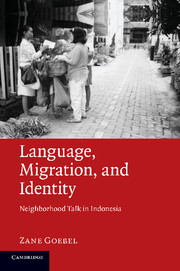Book contents
- Frontmatter
- Contents
- Figures
- Diagrams
- Maps
- Tables
- Extracts
- Preface
- Conventions
- 1 Introduction
- 2 Long-term Processes of Enregisterment
- 3 Enregistering Local Practices and Local Spaces
- 4 Linguistic Signs, Alternation, Crossing, and Adequation
- 5 Women, Narratives, Identity, and Expectations in Ward 8
- 6 Learning to Become a Good Ward Member
- 7 Emerging Identities in a Monthly Ward 8 Male Meeting
- 8 Chineseness as Deviance
- 9 Language Ideologies and Practice in Ward 5
- 10 Conclusions
- Notes
- References
- Index
6 - Learning to Become a Good Ward Member
Published online by Cambridge University Press: 04 August 2010
- Frontmatter
- Contents
- Figures
- Diagrams
- Maps
- Tables
- Extracts
- Preface
- Conventions
- 1 Introduction
- 2 Long-term Processes of Enregisterment
- 3 Enregistering Local Practices and Local Spaces
- 4 Linguistic Signs, Alternation, Crossing, and Adequation
- 5 Women, Narratives, Identity, and Expectations in Ward 8
- 6 Learning to Become a Good Ward Member
- 7 Emerging Identities in a Monthly Ward 8 Male Meeting
- 8 Chineseness as Deviance
- 9 Language Ideologies and Practice in Ward 5
- 10 Conclusions
- Notes
- References
- Index
Summary
Introduction
In Chapter 5 I explored how expectations about social conduct in this diverse and transient ward emerged through narratives. Such interactions can be characterized as local-level speech chains which help constitute and reproduce a small community of practice (COP) and with it a number of locally emerging SRs. In this chapter I explore how one newcomer's observations of such conversational activities helps reproduce and change the signs that constitute the locally emerging SRs discussed in Chapter 5. In this sense, a newcomer's participation as a bystander resembles a “peripheral participant” (cf. Wenger, 1998) within a larger COP where they have the opportunity to learn guidelines on how to become – and what it means to be – a member of a larger COP. I have emphasized “opportunity” to highlight that learning can't be assumed to happen. Indeed, in order to investigate whether any learning has occurred, we need to see whether and to what extent signs from the type of SRs noted in Diagrams 5.2 and 5.3 are appropriated and recontextualized, and then oriented to, or ratified, in that and subsequent interactions. In doing so, we can establish whether and to what extent signs from earlier speech situations are enregistered or change in subsequent interactions. Section 6.1 considers whether and to what extent one newcomer in particular learns such guidelines.
Put slightly differently, what I present in this chapter is a developmental view of conversational style (Tannen, 1984), whereby routine participation in certain speech situations involving certain participant constellations figures in the formation of these styles.
- Type
- Chapter
- Information
- Language, Migration, and IdentityNeighborhood Talk in Indonesia, pp. 109 - 125Publisher: Cambridge University PressPrint publication year: 2010



